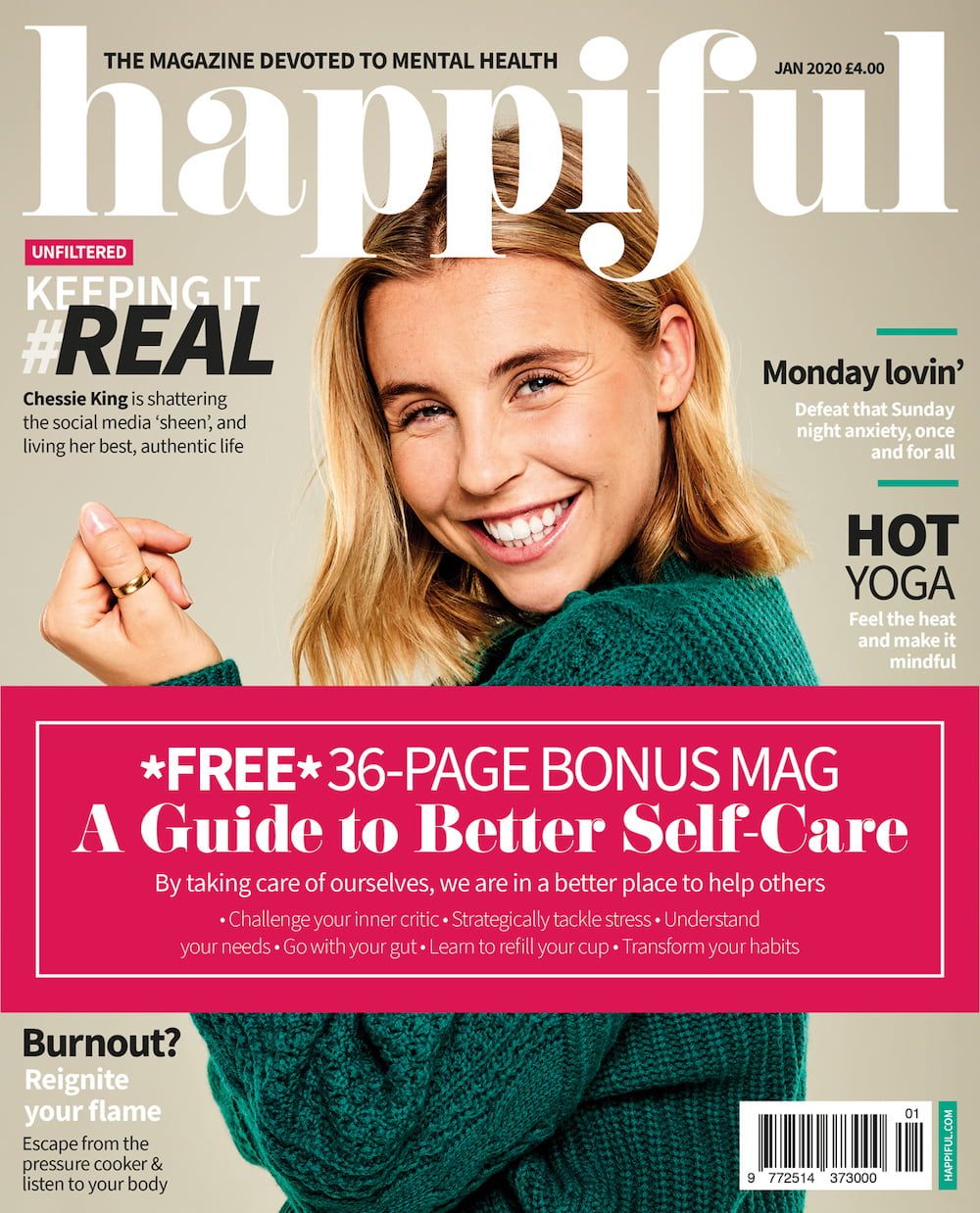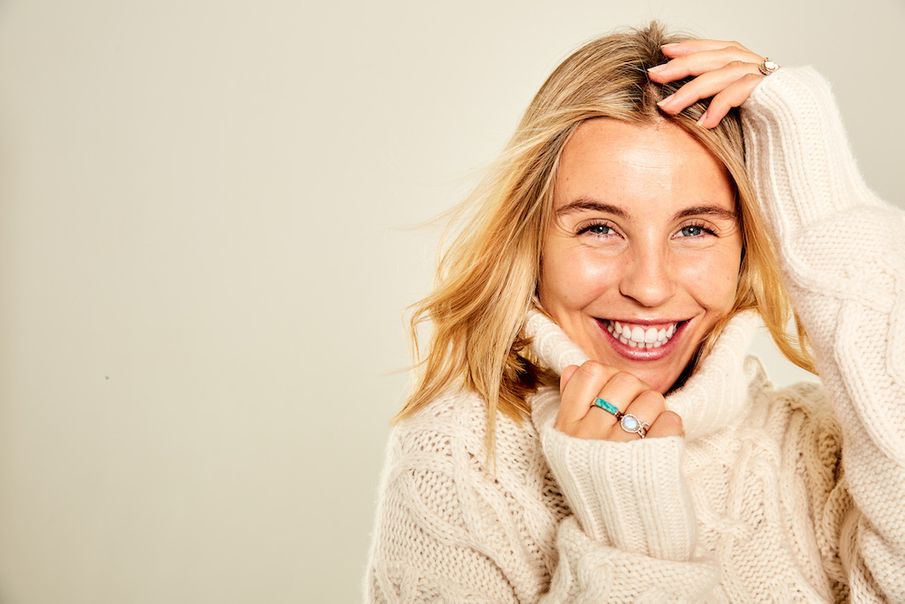Influencer, presenter, and feel-good guru Chessie King is here to tell you: it’s about time you loved yourself. But the journey to the brighter place she is now hasn’t been without its twists and turns. Here we talk about her biggest lesson to date: unearthing unconditional self-love
This is a preview of the full interview, available in Happiful Magazine January 2020. To read the full version, buy in print or subscribe for free online.
It began when she was 16. Before that – Chessie King tells me, as we settle down on a sofa in the corner of the photography studio – she saw her body as a vessel that carried her head around.
But then something changed. It started with anxiety about her height – at 6ft she was much taller than her friends – which moved on to other areas, and then her clothing size.
“Then, when I was 17 years old, I really started focusing on my body,” Chessie explains. “I became wildly addicted to what I looked like.
“I focused on every single part of me that I hated. I became fixated on other people and trying to look like them instead of becoming myself, which is really weird because, at that point in your life, you’re going through so much change.”

Photography | Paul Buller
But things were about to get a lot weirder...
When she was 17, Chessie was scouted by a modelling agency. This was 2010, the year that French Elle released a special edition featuring plus-sized women on the cover, leading The Guardian to declare that fashion’s last taboo had been broken. In hindsight, it may have been a premature assertion – but as Chessie recalls, even at the time, the reality for those on the other side of the camera was far from a revolutionary celebration of diverse bodies.
“They said they would only take me on if I lost weight,” she explains. “And then at every casting, they would hand me a size zero skirt. All of them would watch me try to get into it, but I wouldn’t be able to.”
During this time, the features of Chessie’s body that couldn’t be changed by diet and exercise were quickly altered in post-production while still on set. She recalls a time when she was in Ibiza shooting for a swimwear company, and she watched her body being edited and distorted in front of her eyes.
“They shrunk me to half the size,” she explains. “They smoothed all of the back of my legs out, which is something that I felt self-conscious about anyway. I was watching this happen and thought: ‘Are they doing this to test out a few things?’ But when the photos went out, that’s how they looked. I was like, that’s not me... That is definitely not me.”
I catch myself on days when I am feeling negative and putting myself down and I think, would I ever let anyone else say that about me?
As Chessie explains how these days we all have the ability to airbrush our photos beyond recognition with just our phones, she cuts off to sing along to the song playing over the studio speakers. It’s Lizzo’s self-love anthem ‘Good As Hell’, and despite fighting through the jet-lag after her flight home from Bali the day before, today Chessie is “feeling good as hell”.
Sitting crossed-legged on the sofa, after kicking off her boots as soon as we began our interview, Chessie radiates the confidence of someone who appears to be completely at ease with themselves. But, as she explains, she didn’t get to where she is today without a fair few bumps in the road.
In 2015, Chessie embarked on what she refers to as a “science experiment”. Having spent some time immersing herself in the fitness community after interviewing individuals as part of her work as a presenter, Chessie found herself drawn to bikini competitions.
A highly competitive community, where women train intensely to showcase their physiques to a panel of judges, bikini competitions expect participants to dedicate themselves entirely to the demands of their physical categories, and they are judged on muscularity, condition, symmetry, and presentation.
“I was going to all the fitness classes and working out, and then people were like, ‘You should do a bikini competition, you’re a performer!’ I said, ‘I would never do that, it’s too extreme,’” Chessie recalls. “But then I thought it would be a good science experiment – it would be interesting to see how my body would change from eating well and working out strictly.”

Photography | Paul Buller
With just 18 weeks to transform her body, things got very intense very quickly.
“I was taken places I never thought I’d go,” Chessie reflects. “Sometimes I would be training at five in the morning, crying on a treadmill. People at the gym got to know me because I was there so much, and they would be like, ‘Oh God, she’s on her low-carb day.’”
What began as a light-hearted inquiry into the limits of the human body, quickly became a life-consuming obsession. And despite drastically transforming herself, when the day of the show arrived, Chessie didn’t meet the standards of the judges.
“My feedback afterwards was: ‘Chessie is too big, she’s carrying too much weight.’”
Coincidently, the day of our shoot was exactly four years since that bikini competition. It’s a huge milestone, particularly considering how Chessie says it took her two years after that to return to normality.
“People talk about the 18 weeks leading up to it, which is obviously so physically and mentally exhausting, but then you’ve just restricted yourself every single day. And I rebelled against everything – I literally went into rebellion Chessie mode.
“I couldn’t understand why everyone had willpower and I didn’t, even though I had such strong willpower before. If there was a tub of chocolate, I would eat until I was sick. And then I would be like, how is everyone just eating one?
When you truly are your own best friend, you speak to yourself calmly, and kindly, and you speak to yourself with love and respect
“Bigger support is needed after competitions,” she continues. “It’s masking disordered eating, it’s masking problems that you have covered up in the past – for me that’s what it was.”
For three years following the competition, Chessie didn’t want to speak about it. She was hurt by the feedback, but also didn’t want people to think that it reflected who she was. Turning the tables on that mindset wasn’t easy, but it began with addressing negative self-talk, calling herself on it, and taking steps to be kinder to herself.
“I catch myself on days when I am feeling negative and putting myself down and I think, would I ever let anyone else say that about me? Would I let them say, ‘Your thighs are huge and they look really bumpy?’ Would I ever let anyone say that to me – a stranger or a friend? No. And would I ever say that to someone else? No.
“When you truly are your own best friend, you speak to yourself calmly, and kindly, and you speak to yourself with love and respect.”
To read more of Chessie's exclusive chat with us, where she shares how she found equilibrium, pick up the January issue of Happiful in our shop now, or in supermarkets from Thursday 19 December, or subscribe to read for free online.
For more from Chessie, follow her on Instagram @chessiekingg.

3 Ways to Get Happiful Magazine
Happiful shop: Can't see your copy of Happiful in a store near you? Head to our online shop.
In-store: Pick up your copy in Waitrose, Tesco, Morrisons, Sainsbury's, WH Smiths Travel, Asda or selected newsagents. Find a store near you.
Online: Happiful is completely free to read digitally. To get our January issue in your inbox this Thursday, subscribe now.
Photography | Paul Buller
Hair and Skincare| Amanda Clarke at Joy Goodman
Styling | Krishan Parmar


Comments